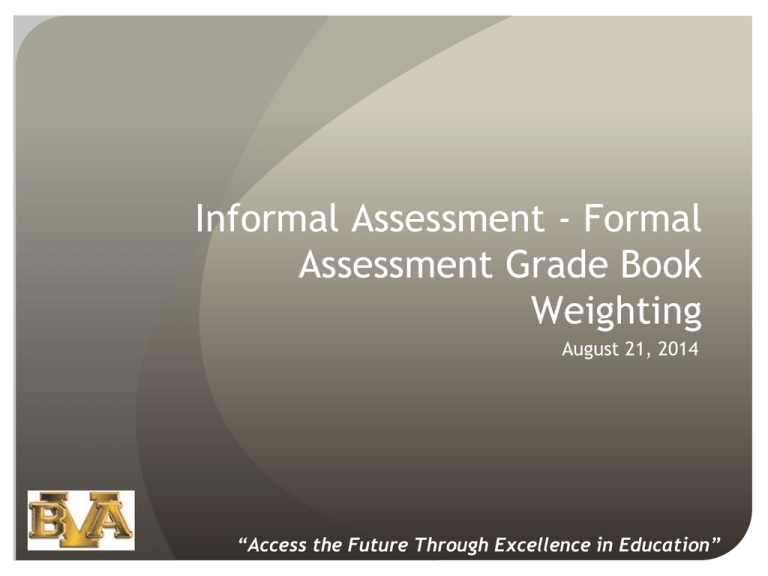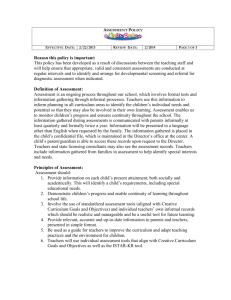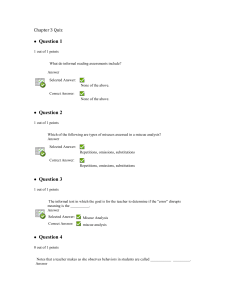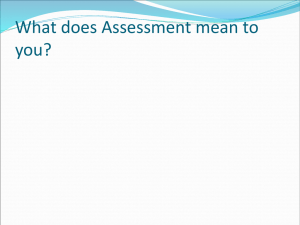Informal Assessments vs. Formal Assessments
advertisement

Informal Assessment - Formal Assessment Grade Book Weighting August 21, 2014 “Access the Future Through Excellence in Education” Agenda • Background • Definition of Informal and Formal Assessment • Examples • Group Activity • Grade Book Setup “Access the Future Through Excellence in Education” Course Grading Criteria Shift: All quizzes, tests, and projects will be graded according to the Belle Vernon Area School District grading policy. Total points will be accumulated for all evaluated efforts in this class rather than having letter grades per each effort. The grading scale is as follows: A 90-100 B 80-89 C 70-79 D 60-69 F 0-59 Emphasis will be on formal assessments. Therefore grades will be weighted. Formal Assessments will account for 90% of a student’s grade (quizzes, tests, projects, performance-based rubrics, essays, graded homework, etc.) Informal Assessments will account for 10% of a student’s grade (homework for completion, class participation, exit tickets, etc.) Comparison of Grade Books: Unweighted AssignmentPts Possible % Homework 1 4 6 Homework 2 5 5 Homework 3 7 7 Homework 4 8 8 Homework 5 5 5 Homework 6 4 4 Homework 7 7 7 Homework 8 3 6 Homework 9 8 8 Homework 10 5 6 Test 1 25 50 Test 2 20 40 Test 3 28 50 Final 129 202 63.86% Weighted 90/10 AssignmentPts Possible Homework 1 4 6 Homework Average 90.32% Homework 2 5 5 Test Avg 52.14% Homework 3 7 7 Homework 4 8 8 Homework 5 5 5 Category Weight AverageTotal Percen Homework 6 4 4 Informal 10.00% 90.32% 9.03% Homework 7 7 7 Formal 90.00% 52.14% 46.93% Homework 8 3 6 Homework 9 8 8 Final 55.96% Homework 10 5 6 Test 1 25 50 Test 2 20 40 Test 3 28 50 Definition of Informal Assessment Remember, for the 14-15 School Year, we will all be grading utilizing the 90% Formal Assessment /10% Informal Assessment Split Informal Assessment Provides useful information that can help teachers to identify the individual strengths and weakness of each student — and most importantly, guide the next steps in instruction. How to plan future instruction so that student needs are met How students should be grouped for instruction so that each student receives instruction at the right level of difficulty If instruction is being delivered at the right pace Which students need individual support “Access the Future Through Excellence in Education” Definition of Formal Assessment Remember, for the 14-15 School Year, we will all be grading utilizing the 90% Formal Assessment /10% Informal Assessment Split Formal Assessment Formal assessments are systematic, preplanned methods of testing students that are used to determine how well students have learned the material that is being taught in the classroom. In other words, formal assessments provide a way of answering the question, “What do the students know?” Each formal assessment has the same set of expectations for all of the students who are taking the assessment. Each formal assessment also has specific criteria used for scoring and interpretation. The main purpose of formal assessment is to measure the amount of knowledge that students have retained from what they have been previously taught. “Access the Future Through Excellence in Education” Examples of Assessments Informal Assessments Formal Assessments Ungraded Homework (Completion) Graded Homework (For Correctness) Notebooks Chapter Tests and Quizzes Class Participation Essay Tests Ungraded Exit Slips Projects Concept Maps Presentations Class Votes or “Clicker” Activities Standardized Tests “Access the Future Through Excellence in Education” Grade Book Set Up • Locate the correct tutorial for your machine on the BVA Home Page (Note: you must be signed in to access Staff Resources) • Open up a Class Roster within your Grade Book • Follow the tutorial to correctly setup your Grade Book • (Note: you will need to set up the categories within each Class Roster) • Mac • PC • Ask Questions! “Access the Future Through Excellence in Education” Have a Great Year BVA Family! Let’s Make it Happen! “Access the Future Through Excellence in Education”








